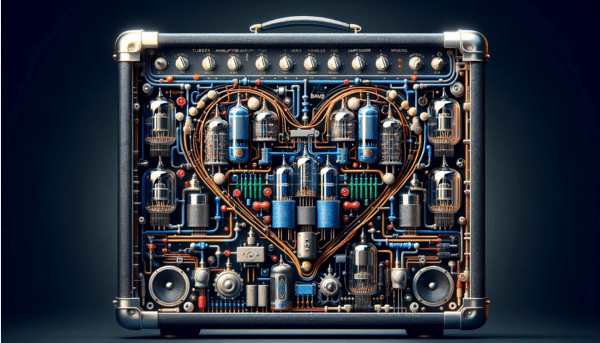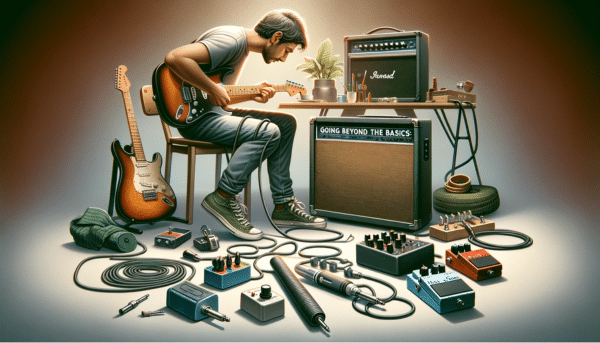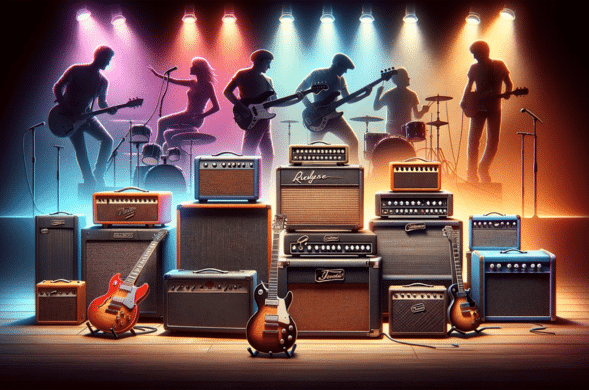Welcome to “Choosing The Right Amp For Your Style Of Play” – the ultimate guide for guitarists seeking to find their perfect sound companion. Whether you’re a beginner strumming in your bedroom or a seasoned performer commanding the stage, this article is your key to unlocking the mysteries of guitar amplifiers.
Here, we dive into how different amps can dramatically shape your music, offering practical advice, personal experiences, and essential tips to guide your journey towards the ideal amplifier for your unique playing style. Get ready to turn up the volume on your knowledge and your sound!
The Short Answer
The key is to match the amplifier to your musical needs and environment. Consider the genres you play, the venues you perform in, and the specific sound qualities you desire. Pay attention to the amp’s wattage, type (tube vs. solid-state), and size to ensure it complements your playing style. Ultimately, the right amp should enhance your sound and help you express your musical voice effectively.
Key Takeaways

Here are the essential points to remember about choosing the right amp for your style of play.
- Understand Your Needs: Assess your playing environment and style before selecting an amplifier. A bedroom practice requires a different amp than a live concert.
- Know Your Genres: Different music genres often require different amplifiers. A jazz guitarist might prefer a different amp than a metal musician.
- Experiment with Settings: Spend time experimenting with the various settings and features of your amp to fully understand its capabilities and limitations.
- The Value of Portability: Consider the weight and size of the amp if you frequently travel for gigs or rehearsals.
- Power Isn’t Everything: Higher wattage doesn’t always mean better sound. It’s more about matching the power to your playing situation.
- Budget Wisely: Balance your budget with your needs. Sometimes, a mid-range amp can meet your requirements without breaking the bank.
- Longevity and Maintenance: Research the longevity and maintenance needs of the amp. Tube amps, for example, require more maintenance than solid-state amps.
- Speaker Quality Matters: The quality of the speaker in your amp significantly influences your sound.
- Feedback Management: Learn techniques to manage and reduce feedback, especially in live performance settings.
- Continuous Learning: The journey of finding the right amp is ongoing. Stay open to new technologies and advancements in amp design.
Keep On Reading (Below) To Learn More
Crafting Your Musical Voice
The Essence of Amp Choice
I’m going to walk you through the intimate relationship between your amplifier and the way you express yourself musically. Choosing the right amp isn’t just about loudness or a brand name; it’s about finding a companion that speaks your musical language and accurately translates your fingers’ dance across the strings.
The impact of your amp choice on sound quality and live performance can often be overlooked. This decision can define the essence of your sound. A good amp does more than just amplify; it sculpts your tone and provides that sonic canvas upon which your musical voice can be painted.
Personal Quest for the Perfect Amp
Your quest for the perfect amp is a highly personal one. It’s not simply a matter of picking up the most expensive or feature-heavy model on the shelf. Instead, choose something that resonates with you, your guitar, and the message you want to convey through your music.
It’s normal to want to buy the biggest amp you see, especially if you’re a Rock or Metal player, but don’t go for that Marshall stack without trying other options first. You might be surprised to find out that your sound is not in the coolest-looking amp!
Mastering Amp Wattage: The Power Behind Your Performance
The Role of Wattage in Performance
Now, as we stride forward in this exploration, wattage is going to be our first stepping stone. Wattage isn’t just a number on a spec sheet; it’s the heart of your amp’s performance ability and will dictate how well you’re heard, regardless of the setting.
Power to the Player
Imagine this: you’ve got your guitar, you’re feeling the groove, but somehow, the sound just doesn’t fill the room. That’s when wattage comes into play. Wattage isn’t about blasting your audience away; it’s about finding that sweet spot of power that meshes with your performance space and style.
Wattage Selection for Different Settings
In a cozy living room or a small practice space, a lower-wattage amp, let’s say around 15 to 30 watts, is going to do the trick. You get the volume you need without overwhelming the space.
Now, step into a larger venue or a setting with a full band, and your wattage needs escalate. Amps ranging from 50 watts and upward become more fitting. They pack enough punch to cut through the mix and keep up with the drum’s tempo and the bass’s rhythm without fading into the background.
Wattage as a Sonic Footprint
Think of wattage as your sonic footprint. Just as a drummer chooses sticks for their precision or resonance, you choose an amp’s wattage for its presence and articulation in the musical conversation. And while wattage is crucial, it’s also about understanding your instrument and ensemble.
A 100-watt beast might give you the stage presence of a rock god, but if your band plays nuanced jazz, you might drown out the subtleties. The right wattage allows your guitar’s voice to be heard, clear and true, no matter the setting.
The following table summarizes key points about selecting the appropriate wattage for different settings:
| Wattage Range | Suitable For | Sound Quality | Typical Genres |
|---|---|---|---|
| Under 30 Watts | Small venues, solo practice | Intimate, controlled | Acoustic, Jazz, Blues |
| 30-50 Watts | Medium venues, small bands | Balanced, versatile | Rock, Pop, Country |
| Over 50 Watts | Large venues, full bands | Powerful, expansive | Metal, Hard Rock, Punk |
Amplifier Anatomy: The Heart of Your Sound

Let’s take a closer look at what sets tube and solid-state amps apart. They’re not just different in design; they offer entirely different auditory experiences that can greatly influence your playing.
Characteristics of Tube and Solid-State Amps
Tube amps, also known as valve amps, use glass vacuum tubes to amplify the sound. There’s a warmth to their sound that often gets described as ‘rich’ or ‘organic.’ When they’re pushed to higher volumes, they tend to provide a natural, musical distortion that many guitarists covet.
On the flip side, solid-state amps rely on transistors to do their magic. They are generally more reliable and require less maintenance than their tube counterparts. Some players prefer them for their clear, crisp sound, especially when it comes to clean tones. Unlike tube amps, solid-state models maintain sound clarity even as you crank up the volume.
Choosing Between Tube and Solid-State
You might find yourself in a bit of a conundrum when deciding between the two. If your style involves a lot of clean playing or you’re after reliability and lower maintenance, you could lean towards a solid-state amp. However, if you’re chasing that classic rock ‘growl’ or bluesy warmth, a tube amp could be more your speed.
Characteristics of tube and solid-state amplifiers:
| Amplifier Type | Sound Characteristics | Maintenance | Suitable Genres |
|---|---|---|---|
| Tube | Warm, Organic, Natural distortion at high volumes | Higher maintenance | Rock, Blues, Classic genres |
| Solid-State | Clear, Crisp, Maintains clarity at high volumes | Lower maintenance | Jazz, Pop, Clean playing |
Remember, though, there’s no one-size-fits-all here. Guitar gods of various genres have used both types to great effect. Think about legends like B.B. King and his Lucille putting out sweet, singing tones through a solid-state amp, or Metallica’s hard-hitting riffs blasted through a wall of tubes.
Sizing Up Your Amp: The Perfect Fit for Every Gig
The Impact of Physical Amp Size on Performance
Size matters, so it’s important to find the right fit for your gig!
Imagine you step into a venue, guitar in hand, amp trailing behind you. You’re there to make an impression, and part of that impression comes from your gear. That’s where size comes into play with amps.
It isn’t just about watts; the physical size of your amplifier can be just as crucial. You don’t want to be the guitarist who brings a massive stack to a coffee shop gig, nor the one struggling to be heard over the chatter in an open mic with a pint-sized practice amp.
The design of the amp isn’t just about aesthetics; it influences the acoustics of your sound. Heavier woods can enhance resonance, adding depth to your tone, while lighter materials might make an amp more portable but can sometimes result in a thinner sound.
Choosing the Right Size for Different Venues
Typically, a combo amp with a 12-inch speaker hits the sweet spot for many musicians playing smaller venues. It’s compact enough for easy transport but packs enough punch to fill a small room with clear, robust sound.
Your back will thank you for not lugging around a behemoth, and your audience will appreciate the full tone that doesn’t overwhelm the space.
Size isn’t just about convenience; it’s about sound quality as well. Amps with 12-inch speakers are known for providing a balanced audio spectrum, which means your lows, mids, and highs are more likely to come through in perfect harmony.
The specifics of cabinet design and speaker quality also play a role in how your amp will project and handle different frequencies.
Harmonizing Gear and Genre: The Art of Selecting the Right Amp
Aligning Amps with Musical Styles
Selecting amps aligned with your music, in my opinion, can be as vital as the instrument itself when it comes to defining your sound. For guitarists, in particular, certain amps resonate better with specific genres of music.
If you’re shredding metal riffs, you’re likely to gravitate toward amps that offer that crisp, high-gain distortion needed. Meanwhile, if you prefer jazz or blues, you’d likely lean towards an amp that delivers a warm, clean tone with plenty of headroom.
Choosing Amps Based on Band Dynamics
Band dynamics and the presence of other instruments can really come into play here.
Playing with a drummer who hits like a sledgehammer? You’d need an amp that holds its ground, ensuring your guitar stands out.
On the other hand, if you’re leaning towards acoustic sets or smaller ensembles, an amp offering rich clarity without too much power might be just right.
Going Beyond the Basics: Fine-Tuning Your Amp Choice

Understanding Volume, Gain and Tone
Understanding the nuances of an amplifier goes beyond its type, wattage, and size. You also need to pay close attention to the amp’s volume, gain, and tone capabilities. These features are pivotal in fine-tuning your sound to match your playing style. Choose an amp that gives you the freedom to dial in your ideal volume without losing clarity or tone quality at higher settings.
The Role of Built-in Effects
Lastly, don’t overlook the built-in effects that modern amplifiers come equipped with. These can offer a whole new dimension to your playing. From reverb to delay, chorus to distortion, having these effects at your fingertips allows for creative experimentation and can inspire new riffs, solos, and sounds. Remember, choosing the right amp is a balance of practicality, quality, and personal expression.
Finding the Perfect Amp: My Personal Experience

Once upon a time, I faced a musical challenge that taught me a lot about choosing the right amplifier. It was during a recording session for our band’s first EP. We were all excited, guitars tuned and drums ready, but something wasn’t quite right.
The sound coming from my 22-watt Fender ’65 Deluxe Reverb tube amp just didn’t match the energy and style of our music. We were playing a blend of rock and blues, and my amp, well, it was more suited for quiet jazz nights.
The problem was clear: my small, 22-watt amp, perfect for practicing at home, couldn’t capture the bold, rich tones our music needed. It was like trying to paint a vibrant picture with only a few colors. The sound was thin, and no matter how much I tweaked the settings, it just couldn’t deliver the punchy, dynamic sound the rock we were playing demanded.
So, I switched to a 40-watt Marshall DSL40CR 1 x 12-inch tube combo amp we had in the studio. Marshall Tube amps are known for their warm, rich breakup, and this one was no exception. As soon as I strummed the first chord, the difference was night and day. The amp roared to life, filling the room with a sound that was both powerful and nuanced. Its warm distortion added character to our music, making the guitar riffs stand out with a classic rock growl.
But the journey wasn’t over yet. With the new amp, the sound was too overpowering for the delicate parts of our songs. I needed to find a balance. That’s where the amp’s tone controls and guitar volume knob came into play. By adjusting the amp’s bass, mid, and treble knobs and the guitar volume, I was able to sculpt the sound, ensuring that the guitar blended well with the band while still maintaining its unique voice.
What I Learned From The Experience
The experience taught me a valuable lesson: the right amp can make or break your music. It’s not just about volume; it’s about how the amp complements your playing style and the genre of music you’re playing. I learned to consider the wattage, the type of amp (tube vs. solid-state), and the settings that allow me to express my musical vision most effectively.
In the end, our recording session was a success. The tracks sounded fantastic, and it was all thanks to choosing the right amplifier. Now, whenever I prepare for a gig or a recording session, I think carefully about which amp to bring. It’s a decision that shapes the sound of my guitar and, by extension, the sound of the music we create.
Frequently Asked Questions
Here are some of the questions I get asked about choosing guitar amplifiers.
If your question does not appear here, please put it in the comments, and I will get right back to you with an answer.
How Do I Know If My Amp Is Too Loud For My Home Practice?
If your amp causes discomfort to your ears or rattles items in the room, it’s too loud for home practice. Consider using lower volume settings, a headphone output if available, or investing in a smaller practice amp.
Can I Use A Bass Guitar With A Regular Guitar Amp?
Using a bass guitar with a regular guitar amp is possible, but not ideal. Guitar amps are not designed to handle the low frequencies of a bass, which can lead to poor sound quality and potentially damage the amp.
What’s The Difference Between A Combo Amp And A Stack?
A combo amp combines the amplifier and speaker in one unit, making it more portable. A stack consists of a separate head (the amplifier) and one or more speaker cabinets, offering more power and customization options.
How Important Is The Speaker Size In A Guitar Amp?
Speaker size significantly impacts the amp’s sound. Larger speakers generally provide better bass response and a fuller sound, while smaller speakers offer more focus on mid and high frequencies.
Does The Material Of The Amp Affect The Sound?
Yes, the material of an amp can affect its sound. Heavier materials like wood can enhance resonance and depth of tone, while lighter materials may result in a brighter, more focused sound.
How Can I Reduce Feedback From My Amp?
To reduce feedback, try lowering the volume or gain, position yourself further from the amp, use a feedback suppressor or noise gate pedal, and avoid pointing the guitar directly at the amp.
What Is A Modeling Amp?
A modeling amp digitally simulates the sound of various other amplifiers, cabinets, and sometimes effects. It offers versatility and a wide range of tones in a single unit.
Can I Use An Electric Guitar Amp For An Acoustic Guitar?
While you can use an electric guitar amp for an acoustic guitar, it may not accurately reproduce the acoustic guitar’s natural sound. Acoustic amps are specifically designed for this purpose.
What Is The Purpose Of An Effects Loop In An Amp?
An effects loop allows you to place certain effects, like delays and reverbs, after the amp’s preamp section. This can result in a clearer, more defined effect sound compared to plugging effects directly into the input.
What Is The Significance Of The ‘Ohm’ Rating On My Amp?
The Ohm rating on your amp indicates its impedance. It’s essential to match this with the impedance of your speaker cabinet for optimal sound and to prevent damage to your amp.
How Does Impedance Matching Affect My Amp And Cabinet?
Impedance matching between your amp and cabinet is crucial for optimal performance and to avoid damaging your equipment. Mismatched impedance can lead to a loss of power and tone quality, and potentially harm the amp or speakers.
Is It Better To Use Multiple Small Amps Or One Large Amp For A Gig?
Using multiple small amps can provide a wider stereo sound and versatility, while one large amp offers simplicity and potentially more power. The choice depends on the venue size and your desired sound.
How Can I Make My Amp Sound Better At Lower Volumes?
To improve sound quality at lower volumes, consider using an attenuator, adjusting the EQ settings, or using amps with built-in low-volume sound optimization features, like a master volume control.
Can Different Types Of Guitar Cables Affect My Amp’s Sound?
Yes, different types of guitar cables can affect your sound. Higher-quality cables generally provide better signal clarity and durability, but the differences may be subtle.
Is It Worth Investing In A Vintage Amp?
Investing in a vintage amp can be worth it for unique tones and character that are hard to replicate with modern amps. However, they often require more maintenance and can be more expensive.
How Does The Room Size Affect My Amp’s Sound?
Room size greatly affects your amp’s sound. Larger rooms may require more power to fill the space, while smaller rooms can lead to sound reflections and potential feedback issues. Adjusting amp settings accordingly can help manage these challenges.
Wrapping Up
As we wrap up our guide on “Choosing The Right Amp For Your Style Of Play,” let’s revisit the key points that’ll help you make the best decision for your guitar journey. Selecting the perfect amplifier is much more than just picking the loudest one or the one with the coolest brand name. It’s about finding a partner that understands and amplifies your musical language.
Remember, the wattage of your amp is crucial. Lower wattage amps are great for small rooms and give a soft, clear sound, while higher wattage amps are perfect for big stages where you need to be loud and clear. The type of amp matters, too! Tube amps give a warm, classic rock sound, and solid-state amps offer a clear, consistent tone.
Size is also important. A big amp might be too much for a small room, and a small amp might get lost in a big venue. And don’t forget about effects and settings! They help you fine-tune your sound exactly how you like it.
Finally, your amp should match your music style. Whether you play gentle acoustic tunes or rock the stage with heavy metal, the right amp will make your guitar sing. By keeping these tips in mind, you’ll find the perfect amp to express your unique musical voice. Happy playing!

Here’s a great video from Fender about some of the more modern modeling amps they offer, which can give you the best “all-in-one” sound for your guitar. Check it out!
What To Read Next ➡ British Vs American Guitar Amplifiers – Ultimate Showdown!
Please Tell Me What You Think!
Your experiences, insights, and adventures in the world of guitar amps are a treasure trove waiting to be shared. Dive into the comments section and share your tales, tips, or even the challenges you’ve faced in choosing the best amp for your guitar and sound.
- What’s your favorite all-around amp, and why?
- Do you generally favor tube, solid-state, or modeling amps?
- Do you think vintage guitar amplifiers are worth the extra money?
- What else is on your mind?
I’m happy to answer any questions you might have!


